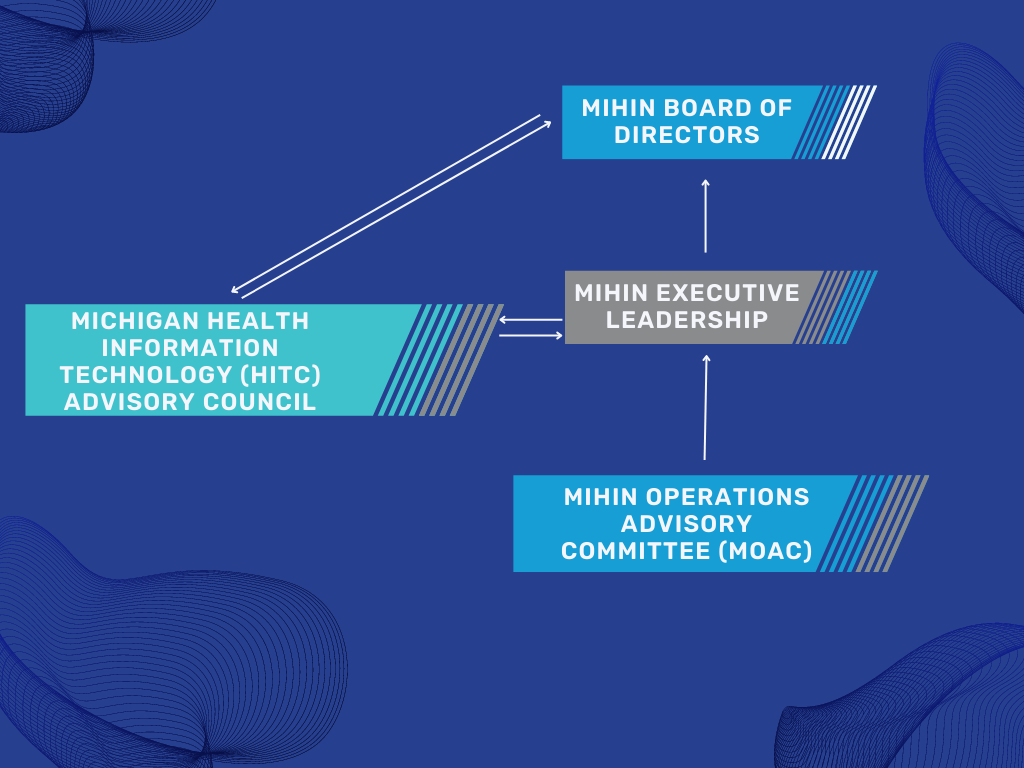Governance
MiHIN Governance Model
Enabling the exchange of electronic health information exchange requires consensus among multiple stakeholders. When complex technical and policy choices are required, governance is established to provide oversight and to hold accountable the parties responsible for exchanging electronic health information.
MiHIN is built on a multi-dimensional set of governance structures. The shared governance model includes relationships with State Agency Partners, The State Health Information Technology Commission (HITC), the Board of Directors, Executive Management Team and the Operational Advisory Committee (MOAC) and its task forces.
The recommendations from the State HITC influence the Board of Directors, who have been appointed to represent the network’s Trusted Data Sharing Organizations (TDSO’s) and to carry out strategic and fiduciary responsibilities. The Board meets regularly to set policies for corporate management and oversight.
Together each structure provides oversight, guidance, and recommendations to MiHIN; intentionally building in mechanisms for meaningful stakeholder feedback into their shared network.


MiHIN Operations Advisory Committee (MOAC)
Established in 2013, MOAC brings together diverse perspectives to assist MiHIN in delivering the best possible statewide health information exchange. It is comprised of organizations that have executed the “Qualified Data Sharing Organization” (QDSO) agreement or have been specifically appointed by the MiHIN Board of Directors to the committee.
These trusted data sharing organizations consist of: health systems, health information exchanges, health plans, hospitals, clinically integrated networks, prepaid health plans, physician organizations, associations that share health information, peer review organizations, consumer organizations, health clinics, and state government agencies.
Collectively the advisory committee aims to:
•Leverage health information exchange pilots state-wide for sustainable adoption
•Improve and validate minimally viable use cases to be operationally feasible and useful
•Network and partner to proactively define new legal and security expectations and responsibilities
•Keep accountability for a successful statewide Health Information Network

How can my organization participate in MOAC?
Your organization is eligible to participate if your organization fully executed a MiHIN legal agreement called the Qualified Data-Sharing Organization Agreement (QDSOA), or an individual from your organization serves on the MiHIN Board of Directors.
How many members of my organization can participate?
Each organization can appoint one representative to the advisory committee. Additional individuals may be invited to attend advisory committee meetings to engage in conversations and provide input, particularly if a specific meeting topic is of interest.
How can we get started with the advisory committee?
To request a qualified data sharing organization agreement, submit a Help Desk ticket at https://mihin.org/requesthelp/.
The timeframe for fully executing a qualified data sharing organization agreement is typically 2 – 4 weeks. Please include the information below in your Help Desk ticket:
- State the official name of your organization
- Include who we can contact at your organization to discuss next steps
- State your organization’s desired timeframe for fully executing a qualified data sharing organization agreement
MOAC’s Conformance Task Force
Task Forces are ad hoc subgroups with clear members, start/end dates, deliverables and deadlines.
The task force will report back to the Quarterly MOAC Meeting the outcome of their working meetings to facilitate a successful statewide Health Information Network.
The goals of the Conformance Task Force Committee include:
- Ensure health care entities and care providers are receiving the quality information they need
- Identify specific data needed in a message to perform efficient transitions of care
- Determine message data specific thresholds
- Identify pain points in conformance specifics
- Determine future incentives for new use cases
